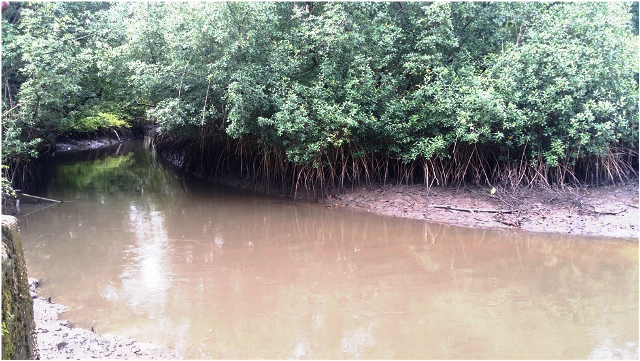The Bakassi mangroves are located in the Rio Del Rey Estuary. The area is a trans-boundary site between Cameroon and Nigeria. The mangroves constitute half of the total 200,000 ha of mangrove forest ecosystems in Cameroon. These mangroves are considered the most important in Central Africa and the 6th in Africa.

Bakassi mangrove are composed of six indigenous species, namely Rhizophora racemosa, Rhizophora harrisonii, Rhizophora mangle (Rhizophoraceae), Avicennia germinans (Avicenniaceae), Laguncularia racemosa, and Conocarpus erecrus (Combretaceae), as well as one exotic species Nypa fructicans (Arecaceae).
The mangrove ecosystem of Bakassi is a very important habitat for fisheries, amphibians, reptiles, birds and aquatic mammals. The mangroves host some 557 marine fish species, including 51 endemic species, 43 threatened, 59 reefs associated, 131 pelagic and 187 deep water. A total of 20 fish species have been documented as vulnerable, endangered, near threatened, critically endangered and data deficient.
Other biodiversity in the area include more than 13 species of Mollusks, more than 10 species of shellfishes and five threatened marine turtle species (Chelonia mydas, Lepidochelys olivacea, Dermochelys coriacea, Eretmochelys imbricata and Caretta caretta).
The Bakassi mangroves are also a uniquely important habitat for the endemic and threatened Cameroon Clawless Otter (Aonyx capensis congicus) and West African Manatee (Trichechus senegalensis). It is also recognized as an important reproduction area and environment for both migratory and resident birds, and 70 species of birds are known to visit the Bakassi mangroves annually.
Mangroves are one of the important ecosystems in the world, providing ideal breeding grounds for much of the fish, shrimp, crabs, and other shellfish harvested by both commercial and artisanal fishermen. Mangrove forests provide habitat to thousands of marine and freshwater species. They protect both the saltwater and the freshwater ecosystems. The mangroves’ complex root systems filter nitrates and phosphates that rivers and streams carry to the sea. They also keep seawater from encroaching on inland waterways. They stabilize the shorelines against erosion. They also protect the land from wind and sea wave damage.
The Bakassi mangroves offer a lot of ecosystem services to the over 300,000 people living in the Bakassi Peninsular. Mangrove forests provide many of the resources upon which the coastal people depend for their survival and livelihood. Within the Bakassi mangrove, one can observe a lot of fishing activities with the people collecting clams, shellfishes, and shrimp etc. Mangrove trees provide fuel for fishing smoking and cooking, medicines, and wood for building of houses and boats.
Today, the Bakassi mangroves are under serious threats from deforestation/degradation leading to decline in species population thus affecting the livelihood of people that depend on these resources. Unsustainable practices such as the frequent use of dynamite, cyanide, and other illegal gears and the widespread harvesting of mangroves for export to neighboring countries and for fish smoking is a serious call for concern. This certainly will be very detrimental in the nearest future.


